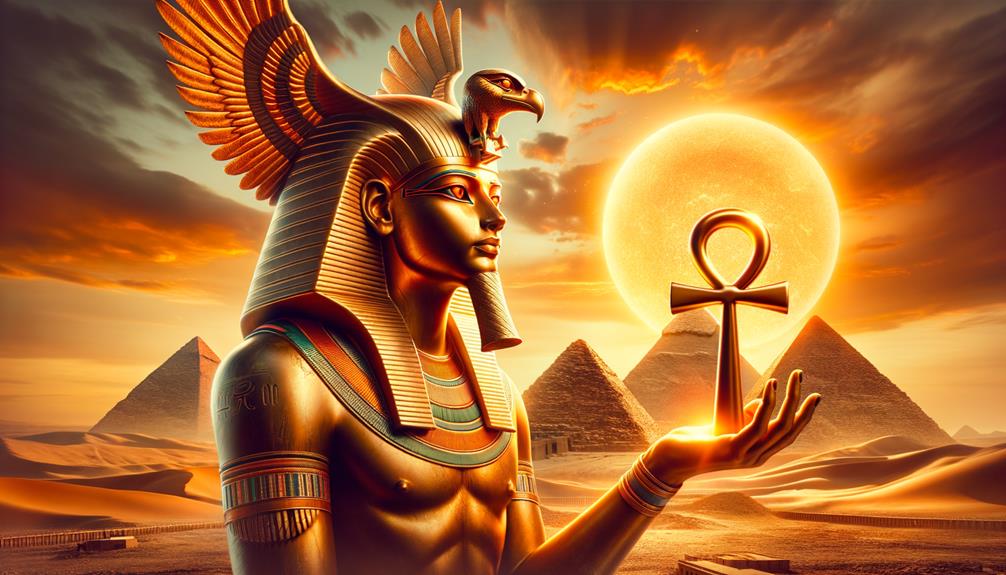Ra, also known as Re, is the revered sun god of ancient Egypt. He is believed to have been born from the determination of Amun or from an egg, with his tears giving life to both humans and gods. Ra is usually portrayed as a man with a hawk's head crowned with a glowing solar disc.
As the supreme god, his adventures represent light, creation, and fire. The pharaohs of Egypt believed they were direct descendants of Ra and built sun temples to honor him. The influence of Ra can be seen in Greek sun gods such as Apollo and Helios. Additionally, Ra has significant links to other Egyptian gods like Horus, Amun, Sobek, and Khnum.
If you keep learning about Ra, you'll find out more about his wide-ranging reign. Remember, every bit of knowledge brings us closer to understanding the rich tapestry of ancient Egypt.
Origins of Ra: The Sun God
Ra, also known as Re, Pra, Raet-Tawy, and Atun, is a fascinating figure in ancient Egyptian mythology. According to the stories, he came into being either through his own sheer willpower or from an egg laid by the god Amun. As the god of the sun, Ra was an important figure in ancient Egypt. His very being symbolized the vital force that gives life.
The story of Ra's creation is a captivating tale. One story suggests that his tears gave birth to the first humans and gods, showing just how powerful he was. Another story suggests that he created life by cutting himself, a symbolic representation of the daily rebirth of the sun. These stories weave Ra into the very fabric of existence itself.
As the ruler of the gods, Ra was in charge of the sun's daily journey across the sky. The Egyptians held him in high regard for his daily trips, known as Matet and Semktet, which marked the sunrise and sunset. These journeys highlighted how crucial Ra was in keeping the universe in order.
Ra's many names reflect his complex nature and the significant role he played in ancient Egypt. His origins and roles show just how much the Egyptians revered the sun and its god, Ra.
Iconography and Symbols of Ra
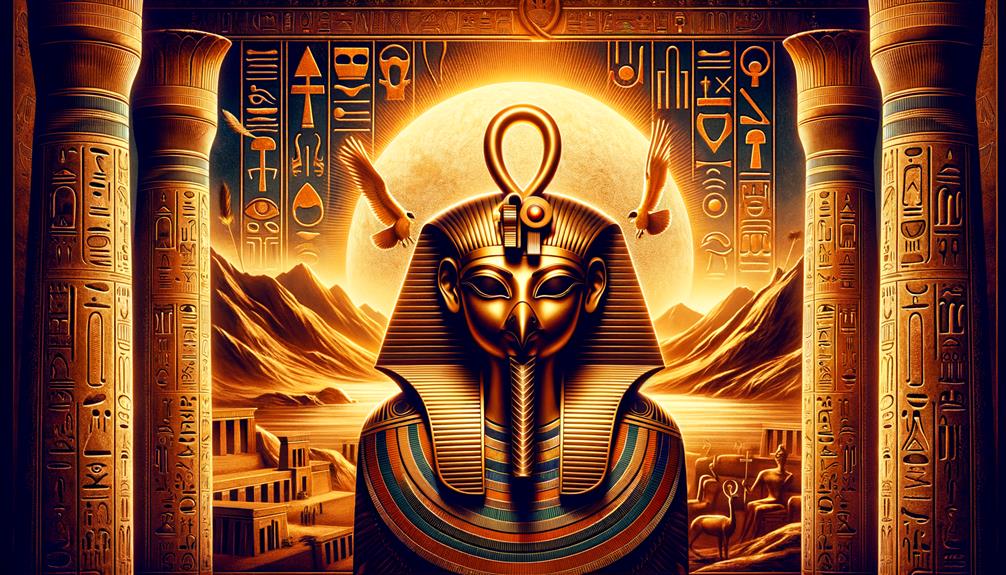
When you look at the representations of Ra, it's easy to see that he is generally presented as a man with the head of a hawk. This links him closely to the sun and the sky. His human shape is a typical feature of Egyptian gods, pointing to Ra's special status as the sun deity of ancient Egypt.
Ra's symbolism doesn't stop there, though:
- His head is often shown with a red or golden circle, or solar disc, which continually reminds us of his control over the sun.
- The Eye of Ra, which stands for his all-seeing power and protection, affirms that this god of creation is ever-present.
- Ra transforms into Khepri, the scarab beetle, when he brings about the dawn, a powerful display of his ability to create and renew.
Ra is frequently portrayed holding an ankh and a scepter which signifies life and authority respectively. These items emphasize his role in the creation stories, where he was responsible for bringing the world and everything in it into existence. These visual cues together give us a clear picture of Ra, reflecting his roles, powers, and the reverence he received in the culture of ancient Egypt.
Ras Duties and Powers
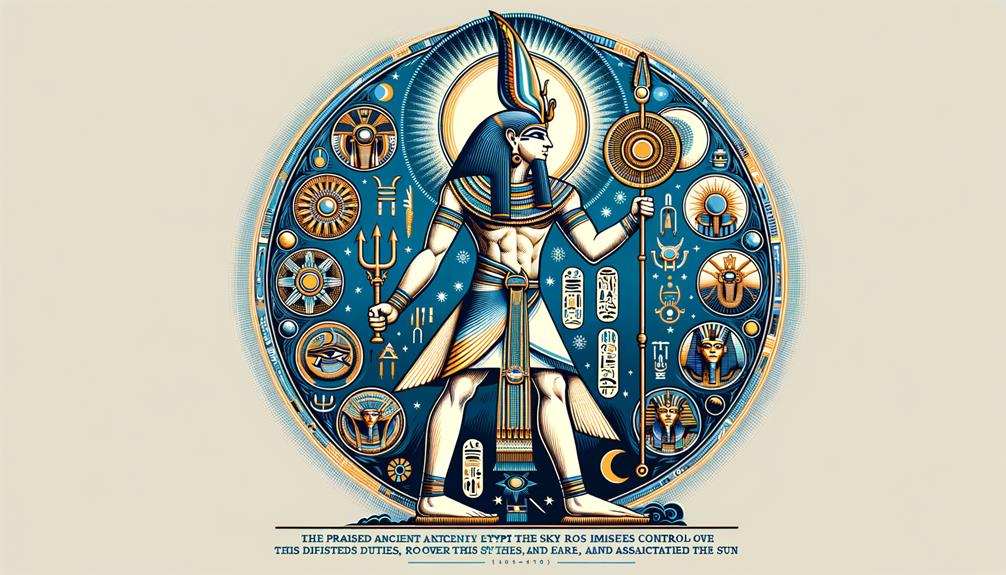
Let's chat about Ra, the ancient Egyptian god whose influence stretched far beyond just being the deity of the sun. His role was deeply intertwined with the essence of life in ancient Egypt. The sun's daily journey from dawn to dusk was his primary responsibility, transforming into Khepri in the morning and Atum at dusk.
But the travels of Ra were more than just celestial happenings. They symbolized the powers of light, fire, and creation, which were critical for life in Egypt. It's fascinating how these two journeys across the celestial waters, known as Matet and Semktet, were more than just natural occurrences.
Ra's significance was also reflected in the creation stories of the Egyptian gods. He was seen as the son of Neith, reaffirming his standing among the divine beings. His association with Maat, the principle of truth, justice, and order, showcased Ra's commitment to keeping the world's balance.
But Ra's power wasn't confined to daytime. He also created the moon, demonstrating his control over the night. So, you see, Ra's roles and powers were diverse, reaching beyond his identity as a sun god. He was crucial to the smooth running of life and order in ancient Egypt.
Ras Influence on Egyptian Rulers
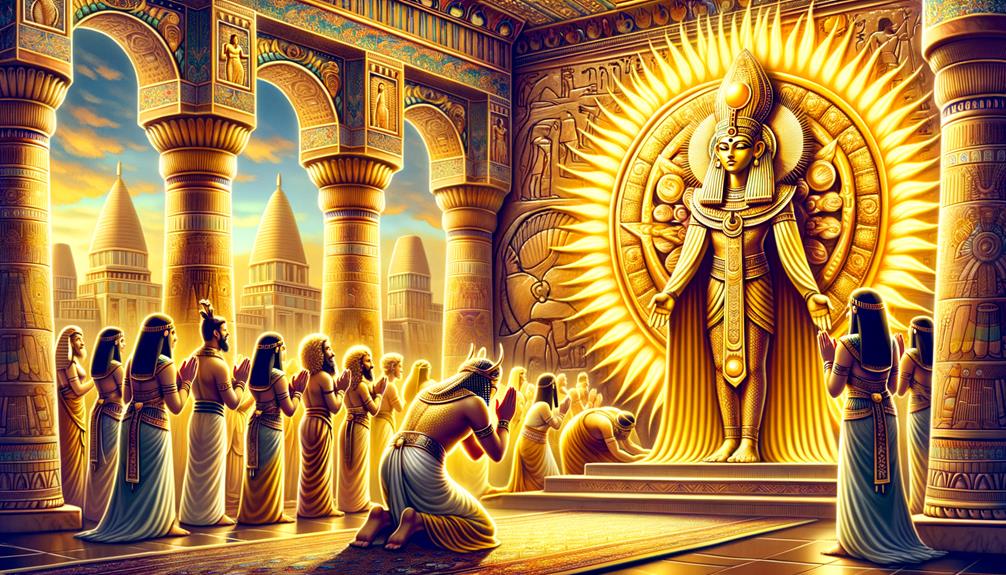
When we think about Ra, the sun god, and his profound sway over Egypt, it's fascinating to note that the rulers of Egypt were often seen as his direct descendants. This divine lineage suggested that the kings were the bearers of Ra's power and wisdom, which was a key source of their clout and their divine right to rule.
During Ra's time, sun temples and chapels were common sights across Egypt. These weren't just architectural marvels; they were sacred spaces where Ra's followers gathered. The king, seen as Ra's progeny, would conduct ceremonies in honor of the sun god in these locations.
Ra's influence can be grouped into three key aspects:
- Theological Influence: Ra was one of the most revered deities in the Egyptian pantheon. His traits were often combined with those of other gods.
- Political Influence: Ra's godly status was leveraged to validate the king's rule over Egypt.
- Cultural Influence: Even with the emergence of Christianity, the veneration of Ra continued, proving his lasting imprint on Egyptian society.
From our study, it's clear that Ra's influence was not just limited to his role as the sun god. He was also seen as the divine patriarch of the Egyptian rulers, which significantly shaped their reigns and the trajectory of Egyptian history.
Comparing Ra With Similar Deities
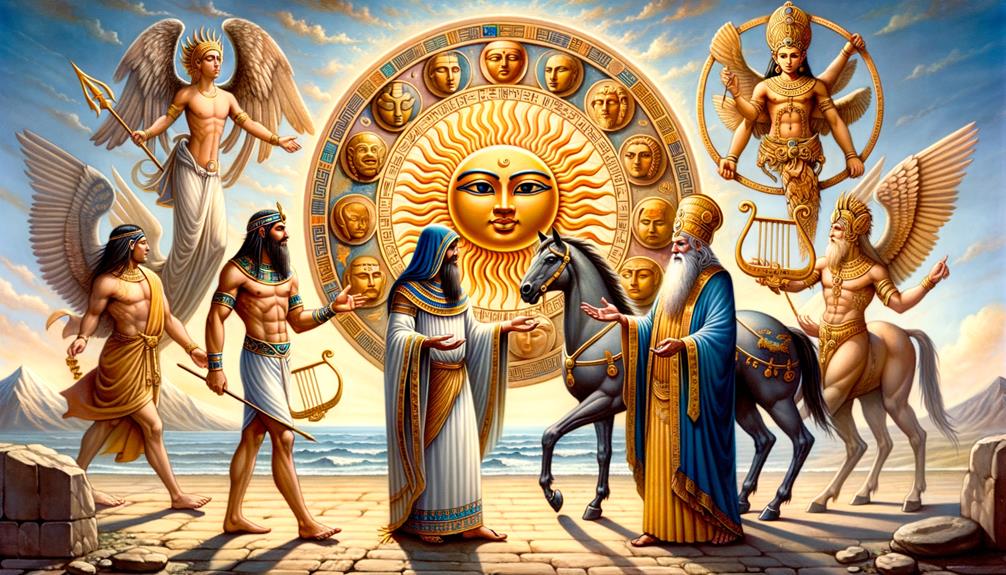
When it comes to the world of ancient mythology, it's fascinating to see how similar Ra, Egypt's sun god, is to other gods from different mythologies. Like the Greek sun gods Helios and Apollo, Ra is also associated with the sun and light, which shows how the sun was universally revered in ancient societies, leaving us all in awe of that bright ball in the sky.
Even within his own Egyptian mythology, Ra has a lot in common with gods such as Horus, Amun, Sobek, and Khnum. This isn't by chance. It's a reflection of how flexible Egyptian mythology can be. Take, for example, the union of Ra and Amun, which resulted in the creation of Amun-Ra. This powerful god symbolizes both creation and illumination, giving us a unique perspective on how the ancient Egyptians viewed the world.
Ra is also linked to Horus through his form of Ra-Horakhty. This connection emphasizes Ra's status as a royal deity and the divine link to the Pharaoh, signifying divine approval of earthly leadership. In another form, Khepri, Ra demonstrates his power over creation and life, representing renewal and rebirth. These connections help us gain a better understanding of Ra's various roles and influence.
Frequently Asked Questions
What Was Sun God Ra Known For?
You might know me as Ra, the sun god, but I'm so much more than that. I'm the one who created everything, the boss of life and death. I'm a symbol of energy, order, and I'm even in charge of the sun's daily journey.
What Is the Ancient Sun God Ra?
As someone who studies ancient Egypt, I can tell you that Ra is seen as the sun itself in the mythology of that time. Picture him as a falcon-headed figure, a symbol of his far-reaching influence as he takes his daily journey across the sky.
Who Is the Goddess of the Sun in Egypt?
Did you know that in Egypt, Sekhmet is revered as the goddess of the sun? Now, she's not your average deity. She has the head of a lioness and is a symbol of war, healing, and the sun's intense power. Intriguingly, she's a bit of a contradiction. On one hand, she's known for sending plagues, but on the other, she's also celebrated for her healing abilities. It's this dual nature of hers that makes her such a fascinating figure in Egyptian mythology.
Is Ra the Sun God Immortal?
Absolutely, Ra is viewed as an eternal entity. Each sunrise signifies his rebirth and thus, his ceaseless existence. This concept of immortality isn't just about living forever, it's also intertwined with his crucial role as the life-bringer and life-maintainer. It's quite an intriguing perspective, isn't it?

